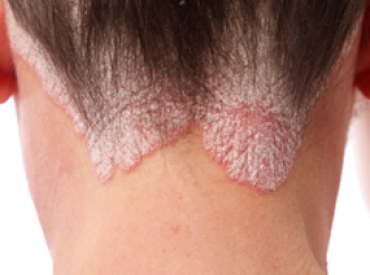Contact Dermatitis, Skin Allergies and Hair Loss
Scalp rashes and hair loss as a result of inflammation are not uncommon but can cause anxiety for those affected.
Often these reactions are not serious and any resultant shedding is temporary. It does, however, depend very much on the specific reason behind the flare up and the hair loss condition that it has caused as to how best to react and the likelihood of seeing regrowth.
 Contact dermatitis or an allergic reaction?
Contact dermatitis or an allergic reaction?
Despite many people's initial worries, a scalp rash may not necessarily be the result of an allergic reaction; it is more likely to be caused by something known as contact dermatitis.
Both have similar symptoms, including skin blistering, itching or burning and a raised red rash, although contact dermatitis tends to be less itchy and more painful.
Contact dermatitis is a skin condition which occurs when, according to Web MD, you touch 'something that took away the surface oils shielding your skin', and it is more prevalent in people with eczema. Symptoms tend to present directly around where you touched the substance you're allergic to.
In addition to the well-known agitator Poison Ivy, some of the most common triggers of contact dermatitis include coming into contact with hair dyes or chemical relaxer treatments, some topical medications, fragranced skincare or cosmetics, latex, nickel and citrus fruit.
If the rash gets worse the longer the irritant was touching your skin, this is called irritant contact dermatitis.
What's the difference?
The difference between contact dermatitis and an allergic reaction, or 'allergic contact dermatitis' is that an allergic reaction involves your immune system, whereas contact dermatitis does not. Instead of touching something that triggers an immediate, localised skin reaction, the allergen in this instance will spark a change in your immune system which will then, in turn, affect your skin.
If you are experiencing a reaction from contact dermatitis or irritant contact dermatitis you are likely to see visible signs, including a rash, straight away, however a similar response from allergic contact dermatitis may take one to two days - or even as long as a week - to manifest.
Usually, you won't get a rash the first time your skin touches something you're allergic to. But that touch alerts your skin to the substance, sensitising it, meaning you could have a reaction the next time. If you got a rash on first contact, chances are you've touched that trigger before without realising.
In both instances, if this happens it is usually beneficial to wash your skin with mild soap and cool water right away, or as soon as you can. You may get rid of all or most of the problem substance which should help to minimize the symptoms. Emollient cream may be applied to help add moisture back into the affected area; also try not to repeatedly scratch your head where possible as this can damage the hair, causing breakage. Depending on the severity of the symptoms, you may need to seek medical attention.
Associations with hair loss
Any instances of mild allergies or contact dermatitis on or around the scalp - sometimes due to a lack of regular hair washing leading to a product- or even minoxidil build-up - are mostly nothing to be concerned about but always check with your doctor, or your hair loss specialist if you are receiving professional treatment, to be sure.
Try to identify what caused the reaction - perhaps a new shampoo or styling product - and take this with you when you see your advisor. You will usually need to avoid using this again. It is worth making a note of the ingredients afterwards, before you throw the product away, in case this happens again with other brands so that, with the help of your GP, you can see any pattern which may help to identify any potential allergens.
There are a number of specific hair loss conditions which cause balding due to inflammation of the scalp and/or follicles though these are not related to the basic allergic reactions outlined above.
These tend to be serious, permanent complaints or side-effects of illnesses which often also affect other areas of the body in different ways too. For instance Lupus often has accompanying inflammation-derived hair loss from Scarring Alopecia - also known as Cicatricial Alopecia - which can destroy hair follicles to the point where they scar over leading to permanent baldness.
Pseudopelade is another condition which causes patchy shedding due to inflammation of the upper hair follicle, whilst the autoimmune condition Alopecia Areata - which can range from mild (bald patches on the scalp) to extreme (complete baldness from head to toe known as Alopecia Universalis) - involves inflammation of the lower follicle bulb.
Although there are Alopecia Areata treatment options available for dealing with the mild-to-moderate stages of this condition, there are no proven cures or truly effective ways of regrowing hair in the more severe cases. Researchers are currently exploring potential cures and treatments for cicatricial alopecia so there may yet be a breakthrough in dealing with this type of hairloss.

The Belgravia Centre
The Belgravia Centre is a world-renowned group of a hair loss clinic in Central London, UK. If you are worried about hair loss you can arrange a free consultation with a hair loss expert or complete our Online Consultation from anywhere in the world for home-use treatment.
View our Hair Loss Success Stories, which includes the world's largest gallery of hair growth photos and demonstrates the level of success that so many of Belgravia's patients achieve.



